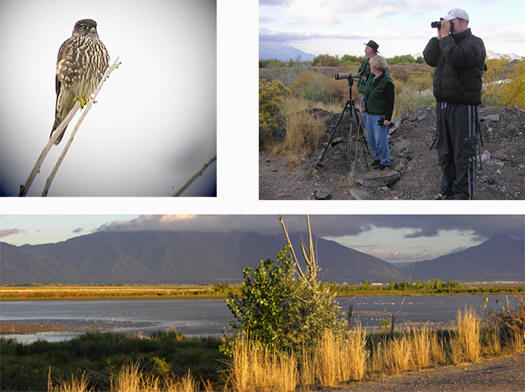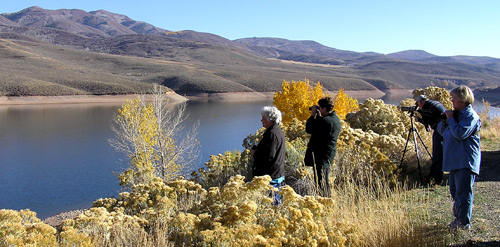Utah County Birders Newsletter
|
 |
|
A Merlin, Milt, Tuula and KC,
and the view of the mud flats from our sit circle - 9 October 2005 |
The Big Sit is like a Big Day in that the object is to tally as many bird
species as can be seen or heard within 24 hours. The difference lies in the area
limitation (inside a 17-foot circle) from which you can observe.
Sit Participants: Eric Huish, KC Childs, Milt Moody, Tuula Rose, Deb Thornton
and Cheryl Peterson.
The TV weather reporters had us all believing we would be sitting in the rain
and wind all day but to our relief we had beautiful weather. Due to this year’s
higher water levels we moved our circle from where we had it the last two years
to take advantage of some mudflats which were loaded with shorebirds. The move
gave us no practical views of the open lake so we were unable to get the Diving
Ducks and Grebes we’ve seen in past years but the number of shorebirds on the
mudflats (12) made up for our missing species. We beat our record big sit total
of 53 by 2 ½ species. We saw a couple Western/Clark’s Grebes we couldn’t ID in
the very distant lake I’m counting as half a species.
KC Childs and I started the sit before dawn at 6:00 A.M. We tried for owls and
rails with no luck. While it was still dark we were able to get a Black-crowned
Night-Heron silhouetted against the water croaking in the dark, Wilson’s Snipe
flying around overhead and a few calling Killdeer. As it got light we quickly
began adding species to our list. Milton Moody and Tuula Rose showed up and
helped us add several birds. We had 50 species by noon when Deb Thornton came by
and joined the sit for a while. The wind picked up in the afternoon but Tuula
and I stayed to 1:30. The last species added before our afternoon break was a
Greater Yellowlegs (#53). I returned to the circle at 5:00 and was joined by KC
and Cheryl Peterson. We added two more species to the list. After KC and Cheryl
left I sat until dark (8:00) watching the sunset and all the birds on the
mudflat.
We had a great time and there was plenty of bird activity to keep us
entertained. Especially entertaining were the two Merlins which would frequently
zoom across the mudflat sending the thousand or so shorebirds up into two
swirling flocks, one flock of dowitchers and one flock of peeps. Once the two
merlins even chased each other. During one exciting chase the merlin raced after
a single peep that was separated from the flock. In the end, with some
high-speed maneuvering, the peep managed to barely escape the merlin and it
wasn’t until dusk that I finally saw one of the merlins with a kill.
Our Big Sit list total was 55 ½ species; Gadwall, Mallard, GW Teal, RN Pheasant,
PB Grebe, W/C Grebe, AW Pelican, GB Heron, Sn Egret, BCN Heron, WF Ibis, No
Harrier, SS Hawk, RT Hawk, Am Kestrel, Merlin, SH Crane, SP Plover, Killdeer, Am
Avocet, Gr Yellowlegs, Le Yellowlegs, Ma Godwit, Least Sandpiper, Baird’s
Sandpiper, Pectoral Sandpiper, LB Dowitcher, Wi Snipe, Wi Phalarope, Fr Gull, RB
Gull, Cal Gull, For Tern, Rock Pigeon, Mo Dove, B Kingfisher, Do Woodpecker, No
Flicker, BB Magpie, Barn Swallow, BC Chickadee, Ma Wren, Am Robin, Eu Starling,
Am Pipit, YR Warbler, Song Sparrow, WC Sparrow, DE Junco, RW Blackbird, We
Meadowlark, YH Blackbird, Br Blackbird, Ho Finch, Am Goldfinch, House Sparrow.
--------------------------------------------
Field Trip Report
East Canyon Reservoir and Morgan County - 22 October 2005
by Tuula Rose
 |
|
Utah County Birders at East Canyon
Reservoir - 22 October 2005 |
A beautiful fall day and six UC Birders heading north through Provo
Canyon. A good start for a day that turned out perfect. East Canyon
Reservoir gave more than it had promised, even though we did not find the
Pacific loon that had been spotted earlier. But there were COMMON LOONS
all over the place to look through and more winter ducks than expected,
the best being BARROWS GOLDENEYES and HOODED and COMMON mergansers.
We met with Aaron Smith and he took us on a tour around Morgan County,
his home stomping grounds. He took us on Morgan Valley Road on the west
side of Weber River all the way to the town named after one of our own,
Milton, where we checked on a few famous feeder places. We crossed the
river and visited Stoddard Slough WMA to call for soras and rails. No
show, just a couple of answers from an elusive SORA in the thick reeds.
A quick stop at Aaron's brothers place in hopes of seeing chukars and gray
partridge that come to his feeders unfortunately did not produce any this
time. On the way home we stopped at Croydon, where we had good luck at
some feeders on a previous county hunt. No luck again but the time of year
in between summer and winter seasons for birding can be blamed for the
scarcity of species. All and all a good trip in good company (and Eric
added 15 species to his Morgan County list, which made it even more
worthwhile).
Backyard Bird of the
Month
October 2005
Glenn Barlow - Fruit Heights
Sandhill Cranes - Flock of 16 flew over.
Steve Carr - Holladay
Mountain Chickadee - Early for my yard; the first of October.
Eric Huish - Pleasant Grove
Black-headed Grosbeak - A horribly injured bird remained well into
October.
Milt Moody - Provo
Red-breasted Nuthatch - looking very bright and colorful.
LeIla Ogden - Provo
California Quail (Or what was left of it). A pile of feathers in one
place and about 10' away was the complete skeleton. Picked absolutely clean.
Bruce Robinson - West Jordan
Dark-eyed Juncos - Montane birds are coming down.
Reed Stone - Provo
California Quail - Alpha Male on alert, covey feeding in the dirt.
Bonnie Williams - Mapleton
White-throated Sparrow - New for my yard list.
We would like you to share your favorite backyard bird each
month. Please send your favorite bird at the end of the month to
newsletter@utahbirds.org or call 360-8777. If you would like a reminder at
the end of the month e-mail the above address.